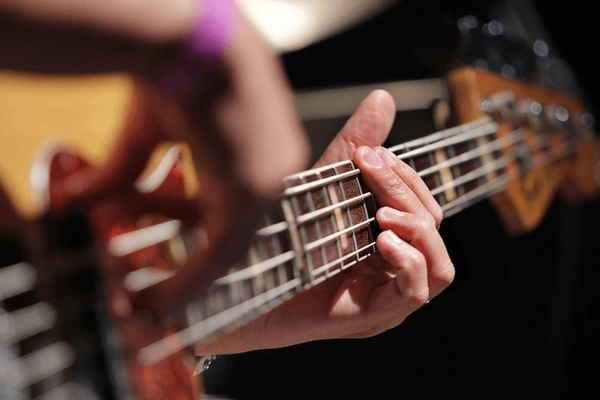How hard is it to learn guitar? That question may have crossed your mind if you’re considering picking up this popular instrument. As someone who has been playing for years, I’ve discovered that learning guitar is not as difficult as some make it out to be. In fact, once you understand the basics and develop a consistent practice routine, you’ll find yourself strumming along to your favorite songs in no time! But before we get ahead of ourselves, let’s dive into what really makes learning guitar challenging and how you can overcome those obstacles.
In this article, I will take you through the common difficulties beginners face when learning guitar and break down simple strategies to help you overcome them. With my personal experience and expertise in teaching others how to play, I am confident that by the end of this article, you’ll feel more equipped and inspired to pick up that six-stringed beauty! So whether you dream of performing on stage or just want a new hobby, keep reading as we uncover the answer to “how hard is it to learn guitar?”
So, how hard is it to learn guitar?
Learning guitar can be a challenging but rewarding experience. It requires dedication, patience, and practice to master the strings. However, with the right mindset and approach, anyone can learn how to play this beautiful instrument.
The difficulty level of learning guitar may vary from person to person depending on their natural abilities and previous musical experience. Some people may find it easier than others due to their innate sense of rhythm or familiarity with music theory. But for most beginners, it will take time and effort to develop the necessary skills.
A good place to start is by familiarizing yourself with the basic chords and strumming patterns. This will help you build a strong foundation for your playing technique. It’s important not to rush through these fundamentals as they will lay the groundwork for more advanced techniques in the future.
Another key aspect of learning guitar is consistency in practice. Regular practice sessions, even if they are short, will help you improve faster than sporadic long sessions. Set aside a specific time each day or week dedicated solely to practicing your guitar skills.
It’s also helpful to have a teacher or mentor who can guide you along your journey and provide feedback on your progress. They can offer valuable tips and tricks that will save you time and frustration while also keeping you motivated.
Learning any new skill takes time, so don’t get discouraged if progress seems slow at first. Remember that everyone starts somewhere, and with persistence and determination, you’ll eventually see improvement in your playing.
In conclusion, learning guitar may not be easy initially but it is definitely achievable with consistent practice and guidance from experienced individuals. So go ahead – pick up that guitar and start strumming! Who knows? You might just discover a hidden talent within yourself waiting to be unleashed through music.
Understanding the Anatomy of a Guitar: Getting Familiar with Each Part
The guitar is a beautiful instrument, with different parts that work together in harmony to create unforgettable melodies. The first key feature on our tour of the guitar’s anatomy is the body. This part can come in various shapes and sizes, but its main job remains unchanged – producing the rich resonance we associate with guitars. When you strum the strings,different tones are generated by vibrations within the body before reaching your ears.
- The neck: This slender piece extending out from the body holds another important component: strings. These can be plucked or strummed to produce sound; their tension can be adjusted using tuning pegs for precise musical notes.
- Fretboard: Running along the neck, it contains metal strips called frets which play a vital role in changing pitch when you press down on a string against them.
Moving further up, let’s shift our focus to two critical components; the headstock and tuning pegs. These sit at very top of your guitar’s neck – what would be ‘north’ if your guitar was a compass! The headstock secures one end of each string while tuning pegs (also known as machine heads) adjust string tension thus controlling pitch.
Finally there’s one more element we cannot miss – pickguard. It’s like an armor protecting body from scratches while playing.
Understanding all these pieces not only enhances appreciation for this versatile instrument but also contributes significantly towards mastering it!</p
Mastering Basic Chords and Strumming Techniques: The Building Blocks of Playing Guitar
Whether you aspire to be the next Jimi Hendrix or simply want to strum some tunes around the campfire, understanding basic chords and strumming techniques is essential. Mastering these building blocks of playing guitar can seem daunting at first. But worry not! This journey, like many others, begins with a single step. At first glance, your fingers might fumble on the strings and pressing down frets could feel like an impossible task. However, before long you’ll find that sweet spot between tension and ease where strumming becomes second nature.
To start with, familiarize yourself with some basic chords. Every song under the sun utilizes a combination of these fundamental chord structures including G major, C major & D major – often referred to as ‘the big three’. Alongside these are E minor & A minor: your gateway into soulful ballads and melancholy melodies. As for strumming techniques, it’s all about rhythm! Get comfortable holding a pick (or using your fingers if you prefer) – keep it loose but controlled in your grip.
- Dowstrokes: When starting out focus on simple downstrokes; this means hitting all necessary strings in one swift downward motion.
- The upstroke: Next comes upstrokes which is essentially doing reverse – bringing the pick back up across those strings.
- Palm-muting:This technique involves lightly resting palm over base end of strings while playing notes. It creates a muted or muffled effect adding depth to your sound!
With time and practice at hand, soon enough those clumsy attempts will turn into beautiful melodies flowing effortlessly from fingertips through guitar strings right into listeners’ hearts…and voila! You’ve begun mastering basic chords and strumming techniques, on your way to becoming a guitar virtuoso.
Read also: yamaha fs830 guitar
Developing Effective Practice Habits: The Key to Learning Guitar Faster and More Efficiently
When it comes to mastering the guitar, developing effective practice habits is crucial. This isn’t just about strumming away for hours on end, rather it’s about adopting systematic routines that target specific skills.
No two individuals are alike; therefore, what works for one may not necessarily work well for another. It’s all about understanding your learning style and adjusting your approach accordingly.
Begin with setting achievable goals – whether you want to learn a new chord every day or master an intricate song by month-end. Then break down these goals into manageable tasks.
- Dedicate time each day solely focused on this task.
- Include warm-up exercises before diving deep into complex chords or finger picking patterns.
- Practice regularly but make sure you take adequate breaks in between so as not to overstrain yourself.
This way, progress becomes visible which motivates you further.
Paying attention to how you practice is equally important. If we compare learning guitar with building a house then practicing correctly would be analogous to laying a strong foundation – the stronger the base, the more enduring will be the structure atop it.
In order to ensure this:
- Spend quality time conscious of every note you play; both your fingers and brain should actively participate in creating music.
- Avoid mindless repetitions and instead focus on correcting errors during practices.
Remember: repetition doesn’t create habits – deliberate action does.

Overcoming Common Challenges in Learning Guitar: Tips from an Experienced Player
Learning to play the guitar can feel like climbing a mountain. It’s a journey filled with numerous obstacles and challenges that might seem insurmountable at first. However, even those monstrous hurdles can be beaten with the right approach and advice from someone who has been there, done that. As an experienced player, I’ve crossed my fair share of rocky terrains on this musical expedition.
Take comfort in knowing you’re not alone in facing these dilemmas. One problem most beginners encounter is pain in their fingers caused by pressing down the strings. Building up finger strength takes time, but it’s achievable with regular practice; consistent yet relaxed effort is key here! Another common issue learners struggle with are chord transitions. You might find your fingers tripping over themselves trying to form different chords quickly enough during a song – however fret not (pun intended)! Start slow, gradually increasing your speed as you become more comfortable.
- Scales training: Regularly practicing scales can significantly boost your chord transition skills.
- Finger exercises: These help build muscle memory making it easier for your fingers to swiftly move between notes.
Lastly don’t underestimate the power of patience and perseverance – Rome wasn’t built overnight after all! No matter how daunting learning guitar may seem initially remember: Every accomplished guitarist was once a novice too!
Remember – every strum brings you one step closer to mastering this beautiful instrument.
You may also like: yamaha piano online registration
Embrace the Journey of Learning Guitar, It’s Not As Hard As You Think
Embrace the Journey of Learning Guitar
Holding a guitar for the first time can feel like being handed an alien instrument, but don’t let that discourage you. Instead, feel the glossy finish under your fingertips and savor the exhilarating blend of nerves and excitement bubbling up inside you. We’re often told that learning to play this intricate stringed marvel is tough work. But in reality, it’s less about laborious grind and more about passion-fueled exploration.
It’s Not As Hard As You Think
Learning guitar isn’t as daunting as it seems when we break it down into bite-sized pieces.
- Start with familiarizing yourself with chords.
- Treat your fingers to the dance across frets on a regular basis; eventually they will glide effortlessly.
- Don’t forget to master those strumming patterns; they are key in making your melodies sing.
Dedication and practice play vital roles, yes! But think back to when you learned how to ride a bike or tie shoelaces – everything seems hard until suddenly…it doesn’t anymore. The same goes for playing guitar: one day those chords just click into place and resonate through every inch of you. So go ahead- pick up that beautiful instrument waiting patiently beside you, tune out all distractions, let your fingers find their rhythm among its strings – because once they do, there’s no looking back from this enchanting journey called ‘learning guitar’.

